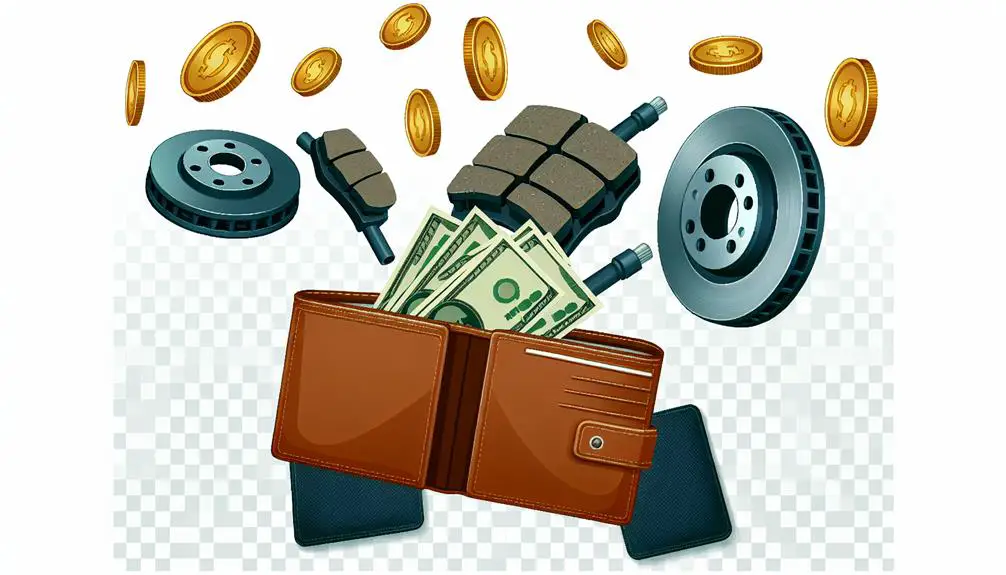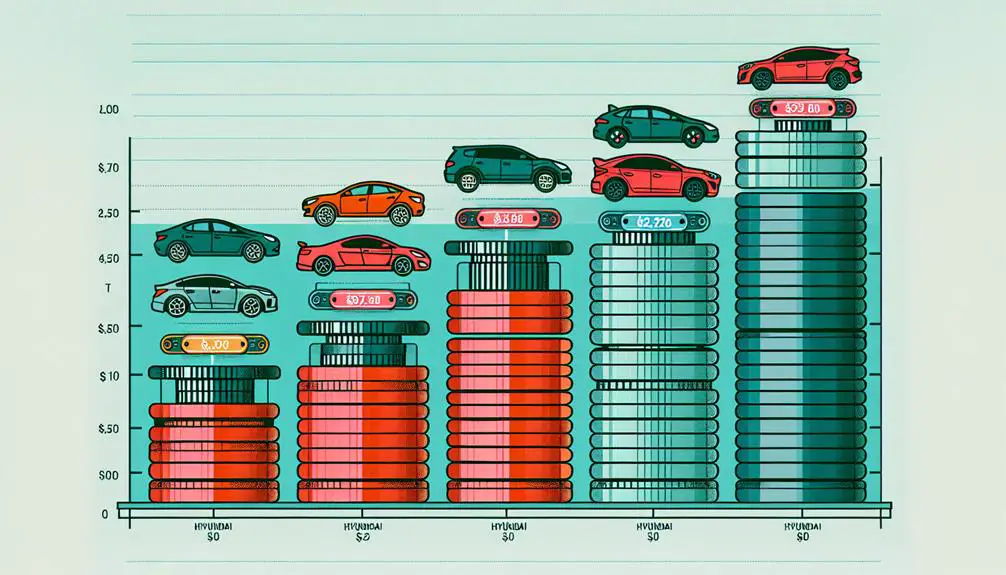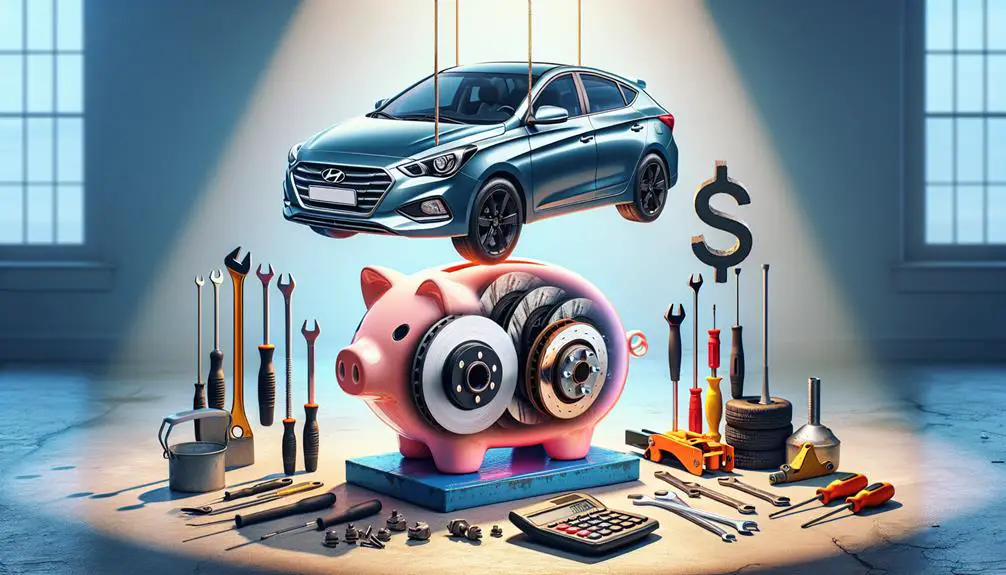The cost of replacing brake pads and rotors on a Hyundai varies based on model and whether you choose DIY or professional services.
Factors such as the quality of parts used, labor costs, and the location of the service provider can all impact the total cost.
For a more accurate estimate, it is recommended to consult with a trusted mechanic or service center.
Understanding Brake Pad and Rotor Costs

Comprehending the costs of brake pads and rotors for your Hyundai involves considering several factors that influence the final price. You're looking at a range that can vary widely, depending on the model of your car and the quality of the parts you choose. It's not just about picking any replacement; it's about grasping what you're paying for.
For starters, brake pads for your Hyundai can cost anywhere between $50 to $150 for a set. On the other hand, rotors are typically pricier, with prices ranging from $200 to $400 per pair. But remember, you're not just paying for parts. Labor costs can greatly affect your total expenditure. Depending on the service center, labor can add an additional $100 to $300 to your bill.
You might wonder why there's such a wide range in prices. Well, it boils down to the materials used and the brand reputation. Higher-end, long-lasting materials will obviously cost you more upfront but can save you money in the long run because of their durability. Cheaper options might seem appealing initially, but frequent replacements can add up, making them more expensive over time.
Factors Affecting Replacement Prices
Knowing the cost of brake pads and rotors for your Hyundai sets the stage to investigate what influences these prices. Several factors come into play, and comprehending them can help you navigate the costs more effectively.
First and foremost, the type of parts you choose greatly impacts the price. You've got options ranging from genuine OEM parts, which are often pricier, to aftermarket parts that can be more budget-friendly. OEM parts guarantee compatibility and performance, while aftermarket parts offer a wider price range and sometimes innovative features not found in OEM parts.
Next, the complexity of the installation affects the labor cost. Some Hyundai models may have brake systems that are more complex and time-consuming to work on, leading to higher labor charges. It's not just about replacing the parts; it's also about the time and skill required to do the job right.
Your choice of service location is another important factor. Dealerships might charge more because of their specialized knowledge and the use of OEM parts. Independent shops, however, could offer lower prices but make sure they've experience with Hyundai vehicles to avoid any compromises on quality.
Lastly, regional variations in labor rates and part costs can't be overlooked. Depending on where you live, the cost of living and operating a business could make your brake job more or less expensive.
All these factors combined dictate the final cost of replacing your Hyundai's brake pads and rotors. By comprehending them, you're better equipped to make informed decisions that balance cost and quality effectively.
Average Costs for Hyundai Models

When considering the average costs for Hyundai models, it's important to know that prices for brake pads and rotors vary widely across different models and years. This variation is due to factors like the specific model's requirements, the materials used, and the labor costs associated with installation. However, you'll find that having a ballpark figure can help you budget more effectively for these essential maintenance tasks.
To give you a clearer idea, let's break down the average costs into more digestible numbers. Remember, these are just estimates and actual prices can differ based on your location and the service provider you choose.
| Hyundai Model | Average Cost Range |
|---|---|
| Hyundai Elantra | $150 – $400 |
| Hyundai Sonata | $180 – $450 |
| Hyundai Santa Fe | $200 – $500 |
For the Hyundai Elantra, you're looking at a lower range primarily because it's a smaller, more compact vehicle, which typically requires less expensive parts and labor. Moving up to the Sonata, costs increase slightly due to its mid-size nature, which can demand higher-grade materials for the best performance and safety. The Santa Fe, a larger SUV, tops the chart not just because of its size but also because of the more strong components needed to handle its weight and functionality requirements.
It's important to view these figures as starting points. Your actual costs could be more or less, depending on factors like where you get the work done and the quality of parts you opt for.
DIY Versus Professional Replacement
Deciding between DIY and professional replacement for your Hyundai's brake pads and rotors hinges on several key factors, including your skill level and the tools at your disposal. If you're mechanically inclined and have previously worked on cars, tackling the job yourself can save you a considerable amount of money. However, it's not just about having the know-how; you'll also need the right tools. At a minimum, you'll need a jack, jack stands, a lug wrench, and the specific tools required to remove your Hyundai's wheels and brake components.
On the other hand, opting for a professional to handle the replacement ensures that the job is done correctly and safely. Mechanics have the experience, tools, and knowledge to diagnose any additional issues that mightn't be apparent to the untrained eye. While this option comes with a higher cost upfront, it can provide peace of mind, knowing that your vehicle's braking system is in expert hands.
You'll also need to consider the value of your time. A professional mechanic can typically complete the job in a few hours, whereas doing it yourself might take a significantly longer, especially if it's your first time. Before diving into a DIY project, ask yourself if the potential savings are worth the time and effort you'll need to invest.
Tips for Reducing Maintenance Expenses

To reduce your Hyundai's maintenance expenses, it's important to adopt a proactive approach towards vehicle care and regular servicing. Regular check-ups can catch issues before they turn into expensive repairs. It's not just about reacting to problems but preventing them. For instance, ensuring your brake pads and rotors are inspected during service visits can save you from the costlier consequence of letting them wear down completely.
You'll also want to familiarize yourself with your Hyundai's maintenance schedule, which can be found in the owner's manual. Sticking to this schedule is vital. It's tempting to skip a service appointment when everything seems fine, but maintenance isn't just about fixing problems – it's about preventing them. This proactive stance can lower your costs over time.
Another tip is to use quality parts. While opting for cheaper aftermarket parts might seem like a saving, they can sometimes lead to more frequent replacements or even damage other components, leading to higher expenses down the line. OEM (Original Equipment Manufacturer) parts might be more expensive upfront, but they're designed to work optimally with your vehicle, offering better value in the long run.
Lastly, learn some basic maintenance tasks yourself. Simple tasks like checking tire pressure, changing air filters, or even replacing windshield wipers can save you money. Not only do you pay for parts, but labor costs can add up quickly for tasks that are actually quite simple to do yourself. Armed with a little knowledge and the right tools, you can keep your Hyundai running smoothly while keeping your wallet happy.
Warranty and Service Plan Considerations
Comprehending your Hyundai's warranty and service plan is important in managing maintenance costs effectively. When you're aware of what's covered, you can make informed decisions about maintenance and repairs, potentially saving you a significant amount of money in the long run. Specifically, understanding the coverage for brake pads and rotors can be a game-changer, as these are parts that naturally wear down and need replacing over time.
Here are three key considerations regarding your Hyundai's warranty and service plan for brake pads and rotors:
- Check the Coverage Details: Not all warranties are created equal. Hyundai's basic warranty mightn't cover wear and tear items like brake pads and rotors. However, some service plans might offer discounts on these parts or even include them as part of regular maintenance schedules. It's important to read the fine print or consult with your dealer.
- Understand the Warranty Period: Hyundai typically offers a generous warranty period, but it's important to know when it starts and ends. This understanding helps you schedule necessary maintenance or replacements within the warranty period, if covered.
- Know the Limitations: Even if your brake pads and rotors are covered, there might be limitations based on mileage or conditions of use. For example, if you're using your Hyundai in a commercial capacity or in extreme conditions, this might affect your warranty eligibility.
Conclusion
To sum up, the cost of replacing your Hyundai's brake pads and rotors varies based on several factors, including your model and if you opt for a DIY approach or professional service. On average, expect to spend a few hundred dollars. However, you can save money by doing it yourself or looking for deals.
Don't forget to take into account your warranty and service plans, as they can greatly reduce your maintenance expenses. Stay informed and choose wisely to keep your costs manageable.